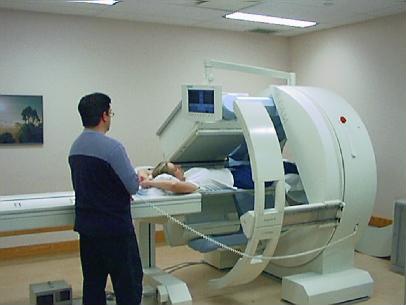
In dynamic SPECT with a slowly rotating SPECT
camera, data are obtained by a standard
clinical acquisition protocol.
That means for instance, 20 - 30
minutes, during which the camera performs a 180 degree
rotation, taking 60 views.
The difference between dSPECT and the traditional clinical
SPECT is
that the tracer is dynamic, which means due to
rapid
uptake and washout in the body, activity in the organ changes significantly
during these 20-30 minutes.
Mathematically, in SPECT, we
reconstruct an unknown emission source f(x) which varies
spatially, x ∈ R3. Projection
data are of the
form
(1) p(⋅,t) = Rt[μ] f(⋅)
where μ(x) is the attenuation map and Rt[μ] is the attenuated Radon transform, mapping in angular direction φ = c⋅t(2) p(⋅,t) = Rt[μ] f(⋅,t).
In other words, as the camera goes from angular
position φ to φ+Δφ, and time
goes from t to t+Δ t, the source f(x,t)
has
evolved from f(x,t) to f(x,t+Δ t), and has therefore
changed significantly. The data p(s,t) are called sinogram, and can be
visualized
as a movie. Here is the case of a kidney acquisition.
You have the feeling that the camera rotates around the patient. For myocarial SPECT this looks much more noisy.
You understand why cardiologists refer to the heart as a donut.
Watching the movie p(s,t),
(s ∈ R2
pixel of the camera),
we have to be aware
that there is a fundamental difference with
a standard
movie (like Dr. Shiwago), where a 3D+time
quantity is displayed as 2D+time.
The sinogram is only 2D+time, displayed as such. In other
words, you might believe
perceiving a spatial object, around
which you rotate, but
there is none, only 2D+time.
Inverting (2) is much harder than inverting (1). The mathematical model
of (1) is based on the photon transport equation.
To invert (2),
you need to complete this by a mathematical model of the
tracer kinetics. The inversion can then no longer
be based on
integral geometry
(like filtered backprojection) or on versions of the EM-algorithm
(like OSEM). Instead, we
need nonlinear optimization techniques to reconstruct f(x,t).
You may check my
publications
to get more information on
the reconstruction
technique. We are holding a patent for this slow rotating
reconstruction method.
Let us look at some reconstructions based
on data like the kidney sinogram. Notice that we are now displaying a 4D
quantity f(x,t). The first movie
is surface rendered. Notice that a study of approximately 20 minutes is visualized.
The isosurface of constant activity shrinks into the interior
of the organ, because the tracer is washed out into the bladder.
This gives the impression that the organ shrinks.
The ureter shows up after some delay, while it is initially
absent, as there
is no activity.
This is interesting, yet
certainly not the way doctors would like to see the reconstruction.
The following is
also surface rendered.
hot_kidney1.mpg
hot_kidney2.mpg
renal.avi
Interestingly, one of the ureters does not show up in the
reconstruction. This does not mean the test person does
not have it,
but that is was carrying significantly lower activity, so that the thresholding gave it 0 value.
The following two movies show a representation
by partial volume rendering. You can see the hot zone
inside the organ
and can notice the change of activity.
The rotation around the object is created for the
convenience of the observer.
partially_volume_rendered1.mpg
partially_volume_rendered2.mpg
ideally_volume_rendered.mpg
Doctors would typically prefer to see the organ reconstruction trace-by-trace. That would be as follows.
dynamic_trace.mpg
These images represent results of self-experiments performed
at the Vancouver General Hospital in cooperation between
my
team and the team of Anna Celler. We also used phantoms
to test our reconstruction techniques. That could look as
follows.
hot_bottles1.mpg
hot_bottles2.mpg
surface_rendered_bottles.mpg
In (2) one assumes the attenuation map μ(x) known.
This is usually possible if the dSPECT study is combined with
a
transmission study (like a CT). But mathematicians have
also tried to invert the operator
(μ,f) → R[μ] f simultaneously.
F. Natterer has contributed to this line, and so has my
team in cooperation with J.-P. Esquerré from Purpan
Hospital in
Toulouse. This is a difficult non-linear
ill-posed inverse problem. See e.g. the following
paper: